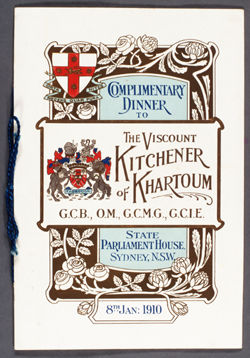 |
|
|||
|
|
||||
 |
| Towards
Federation: 1870-1900
Following the withdrawal of the British garrison in 1870, the colonies slowly came to the realisation that defence was not a matter of individual effort. To be effective, it needed co-ordination at the national level. In 1877, at the insistence of New South Wales, Major General Sir William Jervois (who later became Governor of South Australia) and Lieutenant Colonel Peter Scratchley RE were made available to advise the colonies on defence matters. A succession of inter-colonial conferences, to consider the defence of Australia, were held from the early 1880s. These initiatives clearly illustrate the importance of the defence debate as a factor in the overall impetus for federation. While a gradual process, training and efficiency of the colonial forces did improve. The introduction of higher defence structures, and the posting of British officers and warrant officers to appointments in these higher headquarters, as well as into units, introduced an air of reality into colonial defences and did much to improve the efficiency of colonial regiments. While the colonies believed the Torres Strait, New Guinea and King George's Sound were an Imperial responsibility, they also recognised their strategic importance. A small detachment of Royal Marines was stationed at Port Albany, on Cape York, between 1865 and 1867. After their withdrawal, Queensland maintained a tenuous presence there, although it was realised that Thursday Island would be a better location. The threat of German annexation of New Guinea led Queensland, supported by the other colonies, to annex New Guinea in April 1883, much to the astonished consternation of the British Government which was firmly opposed to further colonial expansion. Resolute action by the colonies finally secured a British Protectorate over southern New Guinea (Papua) in October 1884. Much to colonial chagrin, an astute Germany annexed the northern portion two weeks later. In 1887, the defences of Thursday Island and King George's Sound were discussed at a London conference. By 1893, both areas had been fortified and garrisoned. Meanwhile, railway communications within Australia had developed to the stage where, in spite of different gauges, it was possible to transfer troops rapidly from one colony to another, except Western Australia and, of course, Tasmania. In 1889, Major General Brian Edwards, who had recently completed a survey of colonial military forces, noted that it would be possible to mobilise on a standard brigade basis. In his view, this would 'prevent the unseemly scares which take place (in Australia), whenever the relations of the mother country with a foreign power are somewhat strained'. He further believed purely volunteer units were unsatisfactory - judging paid or partly paid forces ideal for Australia's needs. While neither Britain nor Australia did not fully endorse his views, his concept of mobile rather than static defence, based on coastal forts, gradually came to be accepted. |
||
| Aid
to the Civil Power.
During the late 1880s and early 1890s, Australia's economy worsened, leading to reduced funding for the colonial armies and to the possibility of internal unrest. In 1890, during the Great Maritime Strike, the Victorian police expected rioting on a scale beyond their control. Six hundred troops including 200 from the Victorian Mounted Rifles were called out, and their presence in Victoria Barracks did much to dampen the threat. In the following year, the Queensland shearers withheld their labour when the pastoralists, refusing to recognise the Shearers' Union, began importing non-union labour from other colonies. The ensuing confrontation was deemed sufficiently serious to call out 1442 members of the Queensland Defence Force and send them to centres where the unionists were concentrated. By May 1891, the strike was virtually over, without the employers having conceded freedom of contract to the strikers. The troops received the thanks of the Queensland Parliament but earned the long held suspicion of several sections of the Australian community. It is significant that the Defence Act of 1903 prevented the raising of regular infantry and, for the defence of Australia, fostered a citizen army which could not be used in industrial disputes or serve outside Australia. |
||
| Federation
On 9 July 1900, Royal Assent was given to the Commonwealth of Australia Constitution Act. On 17 September of that same year, an Order in Council approved a proclamation which declared that the union of New South Wales, Victoria, South Australia, Queensland, Tasmania and Western Australia should take effect from 1 January 1901. On 1 March 1901, 28,923 colonial soldiers, comprised of 1,457 permanent, 18,603 militia and 8,863 unpaid volunteers, were transferred to the new Australian Army. However, until the Defence Act of 22 October 1903, these troops continued to be administered under the relevant state acts. (Prior to federation, the separate Military Commandants of the Australian Colonies had already successfully lobbied their governments and the Colonial Office to allow their respective artillery formations to combine into a federal unit, which occurred on the 24th of August 1899.) Major General Sir Edward Hutton, who had previously commanded the New South Wales Military Forces from 1893 to 1896, took command of the Commonwealth Forces from 26 December 1901. His recommendations for the structure of the new force were accepted by Government and, shortly before he relinquished his command in 1904, a Council of Defence, a Military Board of Administration, and an Inspector-General were established by the Defence Act of 1904. The Act was further amended in 1908 to provide an additional member to the Military Board and to re-allocate duties among its members.
Meanwhile, the development of aviation and its use in war had not passed unnoticed, and by 1912 the Military Board had approved the formation of the Australian Flying Corps and the establishment of a Central Flying School at Point Cook, Victoria. (The Royal Australian Air Force was later established as a separate service, in 1921.) |

